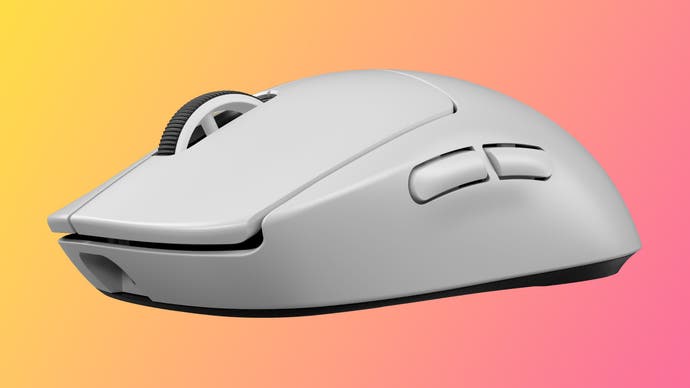Best ultra-light mouse 2024: lightweight gaming mice for FPS gaming
All of the top options tried and tested by Digital Foundry.
Ultra-light mice have quickly become the gold standard for FPS, as they offer a noticeable competitive edge over older and heavier mouse designs in fast-paced PC games. These lightweight mice use clever internal designs, a stripped-back feature set and sometimes honeycomb pattern exteriors to cut mass wherever possible, and the result is a more manoeuvrable mouse that's easier to aim. In our testing, our favourite is the Logitech G Pro X Superlight 2 (£119/$116) - it's also favoured by a lot of the pros - although, we do also have a range of options for you to consider below.
Following early releases by specialists like Glorious and Finalmouse, in 2024 almost every major PC brand now has multiple ultra-light mice with different shapes, sizes and features. Many mice now use more sophisticated electronics, including beefier wireless transmitters capable of polling rates up to 8KHz, more efficient sensors and faster optical switches. Best of all, more advanced weight-saving allows for solid designs rather than the honeycomb shells we saw on earlier ultra-light examples.
After extensive testing of dozens of ultra-light mice in FPS titles like Call of Duty Warzone 2.0, Valorant and Counter-Strike 2, we're ready to make our recommendations. Note that a significant number of the mice below are high-end wireless models, but cheaper wired versions with the same design and features are often available. We've linked to these models where appropriate.
80 grams is our arbitrary cutoff for an ultra-light mouse - and many come in below 60 grams. Both honeycomb and traditional solid body gaming mice are eligible for inclusion. For comparison's sake, most standard mice weigh at least 100 grams; the popular Logitech G502 Hero weighs over 120 grams.
For more on ultra-light gaming mice, check out our article on why ultra-light honeycomb mice are the next big thing in PC gaming gear. We also have some frequently asked questions at the end of the article and a table of the most important specs. And if ultra-light isn't for you yet, check out our full list of contenders for the title of best gaming mouse 2024.
Best ultra-light mouse 2024
- Logitech G Pro X Superlight 2: the professional's choice
- Endgame Gear OP1 8K: the best wired ultra-light
- Fnatic x Lamzu Thorn 4K: esports-grade excellence for less
- Fnatic x Lamzu Maya X 8K: symmetric wireless super-hero
- HyperX Pulsefire Haste 2 Mini: the best ultra-light for smaller hands
- Glorious Model O 2 Pro 4K/8K: a solid platform with many variants
- Zaopin Z2: the best cheap wireless ultra-light
- Razer DeathAdder V3 Hyperspeed: a top-tier design for larger hands
- Glorious Model I 2: ultra-light nine-button alternative to the Logitech G502
- Turtle Beach Burst 2 Air: extremely light and excellent value
- Endgame Gear XM2we: reliable wireless domination
- Incott G23 Pro: discount 8KHz option with hot-swap switches
- Razer Viper V3 Pro: premium price, premium performance
- Cherry Xtrfy M64 Pro: novel design and top-notch specs
- NZXT Lift 2 Symm: stylish and good value in the US
- Fnatic Bolt: competition-ready wireless at a discount
- Corsair M75 Air: excellent for large hands
- Xtrfy MZ1: unique form factor worth adapting to
- Redragon M916 Pro: anime girl meets genuine ultra-light meets low price
- Trust Helox: the cheapest ultra-light mouse
1. Logitech G Pro X Superlight 2
The professional's choice
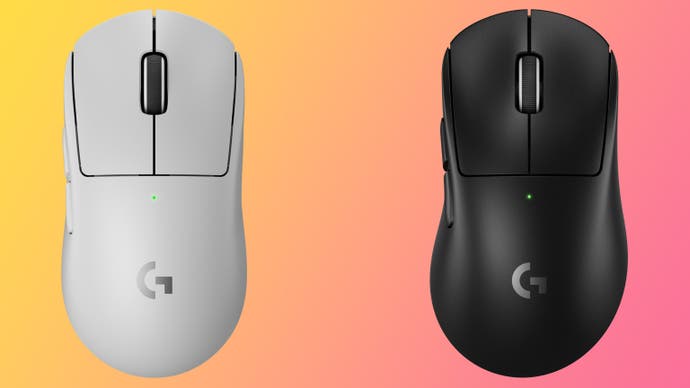
60 grams • Hero 25K sensor • solid symmetric design • 125x64x40mm • up to 4KHz (wireless)
Our top ultra-light recommendation is the popular (£119/$116) Logitech G Pro X Superlight 2, a premium wireless mouse that delivers excellent competitive FPS performance. Note that the default Superlight 2 has a symmetric design suitable for right or left-handers, but an ergonomic model profiled for the right hand is also available: the (£150/$160) Superlight 2 Dex.
Critically, Logitech's Lightspeed wireless is reliable and just as fast as a wired connection, a low weight of 60g is easy to maneouvre and the streamlined shapes suit a wide range of hand sizes. These mice are ferocious competitors that are still comfortable to use in slower-paced games or when noodling around online.
It's not surprising that Logitech takes our top pick - after all, the firm kicked off the trend for wireless ultra-light mice with the 2018 release of the £70/$70 G Pro Wireless, combining an efficient optical sensor with a small, safe shape and Lightspeed wireless at just 80g. The £90/$90 G Pro X Superlight in 2020 represented an evolution of that concept, removing RGB and movable side buttons to cut weight substantially, to 63g. Now, the Superlight 2 is the current gold standard for esports players, with 30 percent of all pros tracked by prosettings.net using a first or second-gen Superlight as of autumn 2024.
This latest model features two key upgrades for lower input latency - up to 4KHz wireless polling and hybrid mechanical/optical switches - plus modern niceties like USB-C charging and longer battery life. You can read our full Superlight 2 review for more details - including a few small nitpicks - but suffice it to say that Logitech hasn't missed with this design. The only thing we don't like here is the price, which is enough to make the earlier G Pro Wireless and the original Superlight better value options overall, even for competitive gaming.
Finally, it's also possible to get the original G Pro Wireless shell - including its fully ambidextrous design with side buttons on either side! - with the upgraded internals of the Superlight 2, including a Hero 2 32K sensor, optical/mechanical hybrid switches, USB-C charging and up to 95 hours of battery life via 2.4GHz Lightspeed wireless. This is called the G Pro 2 Lightspeed, weighs 80g and costs £120/$110.
2. Endgame Gear OP1 8K
The best wired ultra-light
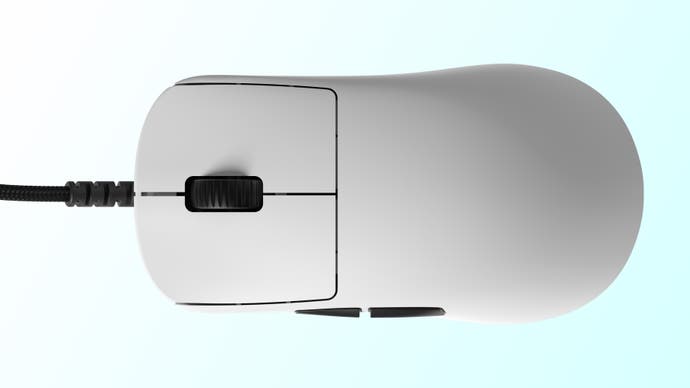
51 grams • PAW3395 sensor • solid symmetric design • 118x61x37mm • up to 8KHz (wired)
The £70/$85 Endgame Gear OP1 8K ticks a lot of boxes for FPS enthusiasts: a streamlined design without holes, a flagship-grade PixArt 3395 sensor and up to an 8KHz polling rate that equals the highest-spec mice on the market. That high polling rate is impressive for the price and translates into class-leading latency figures, but we'd also recommend the cheaper (£54/$65) 1KHz model that's just as good outside of high refresh rate FPS games. Whichever you choose, the symmetric design works beautifully for gaming, particularly with claw and fingertip grips that suit the relatively low shape.
Beyond the headline features, the OP1 8K comes with some nice extra features, including a deliberately accessible design that lets you swap out switches using the included tiny screwdriver. You can find a wide range of switches from Endgame Gear themselves at £6/$7 a pop, which is awesome for anyone with specific tastes or just the drive to experiment. With the default switches, you can also change between multiple debouncing modes in the relatively streamlined software. You'll also find grip tape, replacement skates and a cable tidy in the box, which is again unexpected given the reasonable price.
Endgame Gear isn't the best-known brand, and that's a shame - they consistently deliver exactly what it says on the tin: esports-grade peripherals with no useless frills, genuinely end-game gear. The OP1 8K is a proud continuation of that tradition and well worth your consideration.
3. Fnatic x Lamzu Thorn 4K
Esports-grade excellence for less

52 grams • PAW3395 sensor • solid ergonomic design • 119x65x42mm • up to 4KHz (wireless)
The collaboratively constructed £95/$100 Fnatic x Lamzu Thorn is my go-to mouse right now, offering an ergonomic winning shape, responsive wireless with up to 4KHz polling and a top PixArt 3395 sensor in an eye-catching orange body weighing just 52 grams. Sure, there are lighter wireless mice - see the Burst 2 Air - but the combination here is simply outstanding in its execution.
I think the reason I like this mouse so much comes down to two things: the performance and the design. The performance is simple to explain, with the 4000Hz polling, optical switches and extremely good latency figures, but the shape is perhaps more subtly excellent. The key in my eyes is the relatively tall rear hump, which makes for a comfortable grip in palm or claw, while the relatively wide right side means there's plenty of space for your ring and little fingers. The matte coating is also excellent, providing tons of grip, while the optical switches are some of the best I've ever tested. Thanks to these qualities, I found the Thorn immediately useable in fast-paced titles like Counter-Strike 2 and Hades 2, and it's also more than comfortable enough to use in slower-paced fare like Mechwarrior 5 or day-to-day computer use.
There are some small design oddities - like the latticed base and a titchy, unlabelled on/off switch on the bottom of the mouse - but none of them affect the Thorn's usability. To counteract these, there are also some great small touches, like the soft cloth bag which comes with a smartly angled charging cable that almost works like a miniature mouse bungee. There's also grip tape, replacement mouse skates and even a bottom skin to prevent dust buildup inside the mouse.
Overall, the Fnatic x Lamzu Thorn is a premium esports mouse that absolutely delivers in-game and looks great at the same time.
4. Fnatic x Lamzu Maya X 8K
Symmetric wireless super-hero

47 grams • PAW3950 sensor • solid symmetric design • 124x65x40mm • up to 8KHz (wireless)
Nope, you're not seeing double - the Fnatic x Lamzu Maya X 8K is essentially the symmetric version to the Thorn above, again offering esports-grade specs in an eye-catching orange colourway. This £120/$120 design suits me even better, and made getting back into Counter-Strike 2 a lot easier than I was expecting. The shape, sensor and skates are all perfect.
No matter which of the two available sizes you choose, you get a 2.4GHz wireless dongle capable of up to 8000Hz polling - excellent for high refresh rate gaming - plus PixArt's flagship 3950 sensor and Omron low-latency optical switches. The shape here is similar to something like the Logitech G Pro X Superlight 2, and should suit a wide range of hand sizes - with the 47g 'X' (124x65x40) being better for larger hands and the 45g 'non-X' (119x62x38) for smaller.
As with the Fnatic x Lamzu Thorn, you get a lot for your money here - especially with a nice cloth bag, a soft and flexible mouse cable, replacement mouse skates, grip tape and an optional plastic cover to better safeguard the open bottom. Prices can be better on Fnatic's official store than the Amazon links above, so it's worth checking both.
5. HyperX Pulsefire Haste 2 Mini
The best ultra-light for smaller hands

59 grams • PAW3395 sensor • solid symmetric design • 117x62x37mm • up to 1KHz (wireless)
The £70/$60 HyperX Pulsefire Haste 2 Mini is a brilliant wireless mouse for those with smaller to mid-sized hands, with excellent specs and a comfortable design.
This is a solid 59g mouse with a symmetric shape, with diminuitive dimensions that nonetheless flare towards the back of the mouse. Combined with the top-end PixArt 3395 sensor, matte coating and optional grip tape, this makes for an easy mouse to use with precision and accuracy, and I found myself choosing it over rivals from Logitech and Turtle Beach when grinding through the levels in Call of Duty: Black Ops 6.
Usability is also strong, with both 2.4GHz wireless and Bluetooth connectivity, a long rated battery life of 100 hours and easy-to-press primary buttons with deep comfort curves and Kailh 8.0 switches. The side buttons are large and conveniently placed, while the scroll wheel is also excellent with clearly differentiated steps.
The only minor criticism I have here is for the software, which works reliably but is perhaps a little on the basic side versus the likes of Razer's Synapse or Corsair's iCUE. Still, that means little system overhead too, and overall performance is remarkably good.
The overall value here is strong, especially in the US where the mouse has been discounted post-launch, with a paracord charging cable, 2.4GHz dongle, simple cloth cover, aforementioned grip tape and replacement feet all included in the box.
6. Glorious Model O 2 Pro 4K/8K
A solid platform with many variants

59 grams • PAW3395 sensor • solid symmetric design • 128x66x38mm • up to 8KHz (wired), up to 4KHz (wireless)
The £100/$80 Glorious Model O 2 Pro 4K/8K is a strong all-around wireless mouse from PC specialists Glorious. Its comfortable, symmetric shape weighs in at an impressive 59g, despite not sporting a honeycomb design, while its 4KHz (wireless) and 8KHz (wired) max polling rates and lightning-fast optical switches offer a small advantage at the high refresh rates preferred for competitive FPS. The experience out of the box is impressive, with options for palm, claw and fingertip grips well-supported for most hand sizes. No software is required to access most functionality, such as changing DPI settings, but you have the option of the Glorious Core 2.0 software to access advanced settings or bind hotkeys if you like.
The top of the line 4K/8K model performed the best in our testing, but there are three better value alternatives to be aware of from the same family: the £90/$80 Model O 2 Pro Wireless, the £100/$65 Model O 2 Mini Wireless Mouse and the £60/$65 Model O 2 Wired. The wireless model adds RGB and Bluetooth connectivity, but it is slightly heavier at 68g, uses mechanical rather than optical switches and operates at a more standard 1KHz polling rate. The O 2 Mini Wireless, by contrast, is even lighter at 57g and has more compact dimensions ideal for smaller hands. Given the lower price and additional features, these are the ones we'd recommend to most people. The wired Model O 2, on the other hand, has a honeycomb back and weighs 59 grams. Its super-flexible cable makes it feel pretty close to wireless, so it's great budget-oriented option that sacrifices very little when it comes to performance.
If you prefer an ergonomic mouse that curves toward your thumb rather than something more symmetric like the Model O 2, you should consider the Glorious Model D2. This is built from the same components and therefore offers identical performance, and is available in the same three varieties: (£99/$65) Model D 2 Pro 4K/8K, £60/$50 Model D 2 Pro Wireless and £70/$57 Model D 2 Wired.
7. Zaopin Z2
The best cheap wireless ultra-light

65 grams • PAW3395 sensor • solid ergonomic design • 123x64x40mm • up to 4KHz (wireless)
The £54/$65 Zaopin Z2 is another strong modern wireless gaming mouse from a smaller Chinese brand. This one comes with 4KHz polling out of the box, alongside the now-standard PAW3395 sensor, a non-ventilated design and somewhat rare Bluetooth connectivity and hot-swappable switches.
I dig the shape too, which is a rather moderate ergonomic design that looks almost symmetric at a glance; it seems to work well in a claw grip but could be used with a palm grip too, depending on your hand size. The mouse skates are nice and big, there are simple controls to change connectivity modes and DPI on the underside and the coating is pleasantly easy to grasp. Build quality is also excellent here for the money, with no flex evident whatsoever. At 65g, the Z2 isn't heavy by any means, but it is noticeably heavier than some of the lighest mice in its class like the Razer Viper V3 Pro and Turtle Beach Burst 2 Air.
You also get some nice add-ons in the box, including grip tape, a screwdriver to install your replacement switches, replacement mouse skates and a nice little cloth bag for the mouse.
8. Razer DeathAdder V3 Hyperspeed
A top-tier design for larger hands

55 grams • Focus X 26K sensor • solid ergonomic design • 122x65x41mm • up to 8KHz (wireless, w/ optional dongle)
The £95/$99 Razer DeathAdder V3 Hyperspeed is designed to come between the £55/$60 wired DeathAdder V3 and the £109/$128 wireless DeathAdder V3 Pro. This intermediate spec has a lot going for it, including smaller dimensions (122x65x41mm vs 128x68x44mm) and a lower weight (55g vs 59g/63g) than its same-gen counterparts. In my mind at least, it's Razer's best ergonomic mouse for FPS right now.
The DeathAdder is one of Razer's longest-running lines, so it's a bit surprising that the entire V3 family is a bit of a departure shape-wise from what's come before. Given the focus on "pro feedback" in Razer's marketing materials, perhaps esports players wanted something more akin to the Zowie EC2 - as that's definitely where the DeathAdder V3 Hyperspeed has ended up. Still, that's a popular shape for a reason, and I found the V3 Hyperspeed a much more natural fit than previous DeathAdder generations - which felt a bit overly wide even in my large-ish hands. The Focus X 26K sensor feels just as accurate as the Focus Pro 30K in the other two DeathAdder V3 models, so I'd choose based on the price and size rather than worrying about the internals.
Unlike other mice that deliver higher than 1KHz polling built-in, Razer has opted for the "8KHz dongle sold separately approach", which simplifies recommendations but is a bit of a bummer when you're forking out the full £100 RRP. Regardless, even the default dongle delivers excellent and reliable performance in competitive titles, with just the top echelon of pros - or enthusiasts with powerful CPUs and high refresh rate screens - really requiring higher polling rates. One advantage of the bundled 1KHz dongle is that it slips neatly into the bottom of the mouse for storage, which grants the Hyperspeed a bit of flexibility for use away from your desktop gaming PC.
9. Glorious Model I 2
Ultra-light nine-button alternative to the Logitech G502
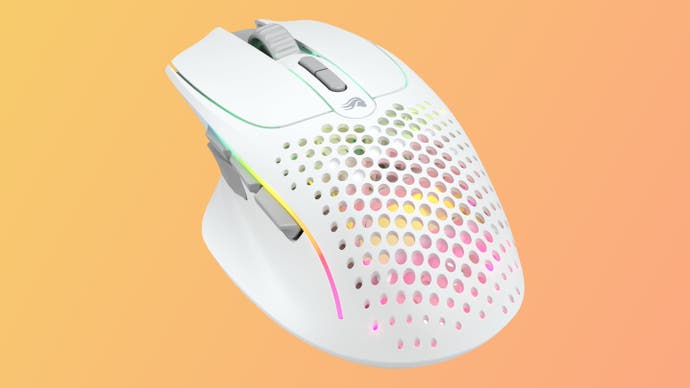
75 grams • PAW3395 sensor • honeycomb ergonomic design • 129x72x42mm • up to 1KHz (wireless)
The £80/$75 Glorious Model I 2 is a superb wireless mouse in the same comfy, high-button count vein as the popular Logitech G502 Hero and Razer Basilisk V3. The difference, of course, is the ultra-light design, wireless connectivity, and high-grade mouse skates. You can also pop off the side buttons to replace them with ones of a different shape, or flat panels if you don't need them and just want a smooth surface to grip. These characteristics make the Model I 2 a much better choice for FPS gaming, without sacrificing the comfort that made these heavier mice so strong. The only thing it's really lacking from these alternatives is a fancy scroll wheel; the Model I 2's is serviceable but doesn't offer an 'infinite scroll' mode. That's hardly a dealbreaker personally, and I'm glad to see some proper competition in this popular space.
If you don't mind a wired mouse, then the £50/$60 Glorious Model I is substantially cheaper. It comes with an older PAW3370 sensor and a slightly different shape, but it still performs excellently thanks to its super-flexible cable and lower 69g weight. Well worth considering!
10. Turtle Beach Burst 2 Air
Extremely light and excellent value

47 grams • PAW3395 sensor • solid symmetric design • 122x67x39mm • up to 1KHz
I believe the £83/$80 Burst 2 Air is technically Turtle Beach's first gaming mouse, as the company has now absorbed the long-running Roccat brand into its own. The Burst 2 Air is more than a historical oddity though, as its low, fat-bottomed shape is extremely comfortable - and at 47g, it's one of the lightest wireless mice we've ever tested.
The other specs here are strong, including a PixArt PAW3395 optical sensor and Turtle Beach's own Titan optical switches, but polling rate is limited to 1KHz - not an issue for 99 percent of players, to be honest. Surprisingly given the low weight, Turtle Beach has opted to include Bluetooth connectivity, making this a useful mouse in a much wider range of scenarios, though RGB lighting has been excised as is tradition with many ultra-light mice. Battery life is reasonable too, at a rated 40 hours for 2.4GHz and 120 hours for Bluetooth. Finally, grip tape and replacement mouse skates are included in the box, which is a nice value-add.
Overall, an excellent option that has become cheaper over time, which is a good thing: more people ought to consider this surprise package.
11. Endgame Gear XM2we
Reliable wireless domination

63 grams • PAW3370 sensor • solid symmetric design • 122x66x39mm • up to 1KHz (wireless)
The £80/$79 Endgame Gear XM2WE is my platonic ideal of a competition-focused gaming mouse - lightweight, wireless, comfortable, reliable. Its clean design suits a wide range of hand types and grip styles, but more importantly it felt immediately natural to use. A 63g design and good adhesion on the glossy side grips allow for rapid readjustment, which is crucial for flicking around in Counter-Strike 2, but the quality of the primary and side buttons, scroll wheel and build quality didn't let me down in regular use either.
There's a flexible USB-C cable in the box for recharging, but you'll get a comfortable 50 hours of battery life thanks to a lack of RGB, an ordinary 1KHz polling rate and the efficient PAW3370 sensor. The base of the mouse features big PTFE skates to help it glide, but there's no place to stash the 2.4GHz dongle - so keep a good eye on it. As with other competitively-minded mice, Bluetooth has been jettisoned to keep the weight down and design simple.
You can read our full Endgame Gear XM2we review for more details, but the short version is that we like this mouse a whole lot.
12. Incott G23 Pro
Discount 8KHz option with hot-swap switches
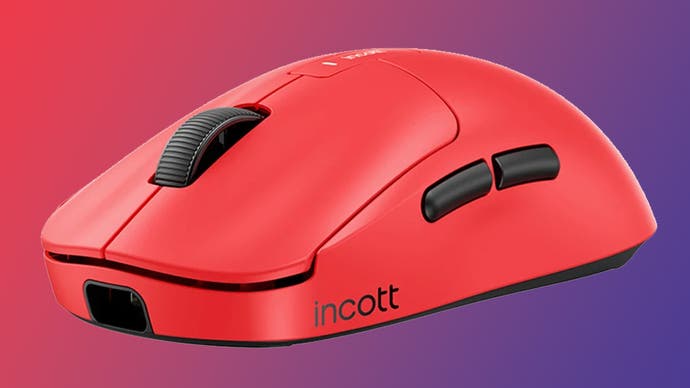
66 grams • PAW3395 sensor • solid ergonomic design • 119x66x39mm • up to 8KHz (wireless, w/ optional dongle)
The £60/$80 Incott G23 Pro is a great example of the growing strength of boutique mouse brands, especially those from China. For the money, you're getting top specs for a wireless mouse, including 8KHz polling, PixArt 3950 sensor and Huano transparent blue pink dot switches.
The G23 Pro's switches are also hot-swappable (!), with little ports on the underside of the mouse to let you take change the feeling of the left and right clicks within a few seconds. A switch puller and three extra pairs of switches are included in the box, from extra-clicky to completely silent options - very cool.
The G23 Pro has a similar shape to the Fnatic x Lamzu Maya X 8K (and hence the Logitech G Pro X Superlight) above, being a little longer and narrower. However, the Maya X is nearly 30 percent lighter, which is nice but does make the G23 Pro feel a little more solid. Like the Maya, the G23 Pro only supports wired or wireless operation, with no Bluetooth support.
Overall, a nice mouse with a neat gimmick, and it's available in multiple colours too. It may not be the most original option, but the value here is impeccable.
13. Razer Viper V3 Pro
Premium price, premium performance
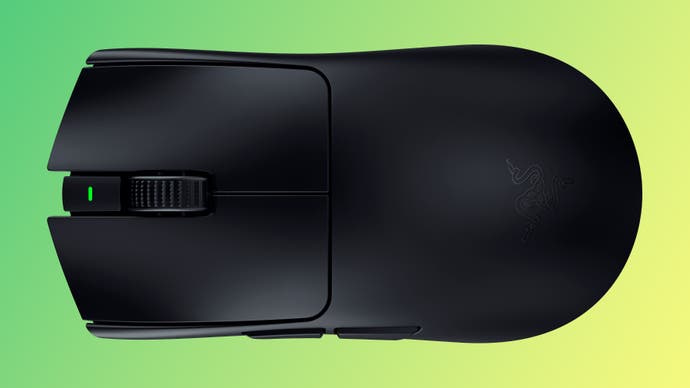
54 grams • Focus Pro 35K sensor • solid symmetric design • 127x64x40mm • up to 8KHz (wireless)
The £160/$155 Razer Viper V3 Pro is the firm's top symmetric gaming mouse, offering excellent performance for fingertip and claw grip styles at an admittedly eye-watering price. I used the original Viper Ultimate mouse for many years after it was released, and the V3 Pro feels like a logical evolution to suit modern tastes: lighter, simpler, sleeker and higher-specced.
At 54g, the Viper V3 Pro is amongst the lighter wireless mice we've tested for its size, and the streamlined shape looks and feels great in the hand - though those with bigger paws may prefer the competing DeathAdder's wider and more ergonomic shape. I do slightly miss the textured rubber side grips from the OG Viper Ultimate, but these did eventually get grimy and start to leak adhesive... so I figure the smooth sides and included grip tape here is a better solution overall. Similarly, the removal of the side buttons from the right side of the mouse is a bummer for lefties, but is something that we've frequently seen as lightweight designs have become increasingly important for marketing purposes. Razer's third-gen optical switches and the scroll wheel are unusually good too, with consistent tactile feedback, the perfect amount of travel and a pleasant sound.
Battery life is also strong here, at a rated 95 hours at 1KHz polling, and recharging is easy via USB-C, even with a third-party cable. You get up to 8KHz polling with the provided dongle, which is a nice change from some of Razer's past high-end mice that required the purchase of a separate dongle to achieve this level of performance. I also appreciate the option in Synapse to switch to 8KHz only in-game, saving battery life when in Windows. Synapse in general is as strong as ever, with plenty of options for adjusting the mouse's settings - though of course there's no RGB here.
All things considered, the Viper V3 Pro is a top-tier, high-performance gaming mouse and a great option for those that prefer symmetric designs and can afford the premium price.
14. Cherry Xtrfy M64 Pro
Novel design and top-notch specs
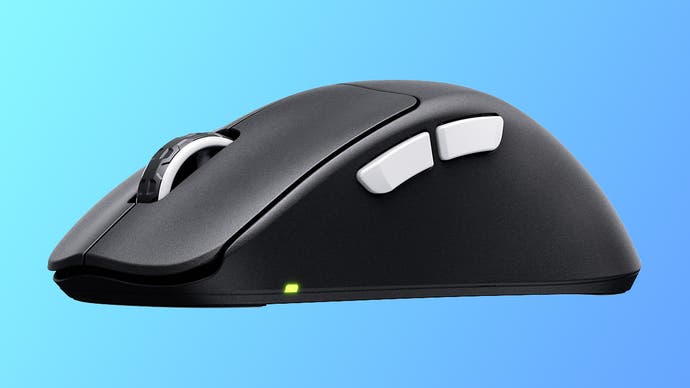
55 grams • PAW3395 sensor • solid ergonomic design • 120x65x40mm • up to 8KHz (wireless)
The £139/$123 Cherry Xtrfy M64 Pro is a powerful but expensive esports-focused mouse that offers 8KHz wireless polling, extremely good click latency and a light weight of 55g, making it a good performer for fast-paced gaming genres like FPS or MOBA. Its design is unusual too, with an extremely low front that allows for some interesting grip styles - but relegates the charging port to the right side, hidden behind a rubber stopper. The esports focus is also visible in its no-software approach to customisation, allowing for all settings such as DPI, polling rate and button debounce time to be changed via a switch and button on the underside of the mouse. Battery life is surprisingly good too, at a rated 90 hours - an estimate which felt accurate in our testing. If you're considering a 4KHz or 8KHz mouse for esports, this is an interesting option that ought to be on your shortlist.
If you prefer a symmetric design, the corresponding mouse is the £139/$122 Cherry Xtrfy M68 Pro. Apart from the shape, which measures a more modest 123x61x40mm, this mouse is identical to the M64 Pro in every way and therefore offers exactly the same performance. Non-pro versions limited to 1KHz polling rates are also available at a lower price: £99/$93 for M68 and £99/$94 for M64.
15. NZXT Lift 2 Symm
Stylish and good value in the US
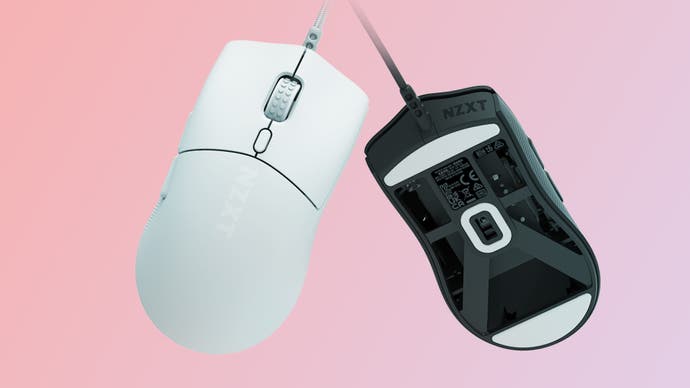
58 grams • PAW3395 sensor • solid symmetric design • 127x67x38mm • up to 8KHz (wired)
NZXT is best known for their imaginative PC cases and performant water coolers, but the company also has a modest lineup of peripherals with mice, keyboards and audio gear. Their latest mouse is the wired NZXT Lift 2, available in two differently-shaped (£53/$40) "Symm" and (£50/$42) "Ergo" flavours.
Like the first-gen Lifts, the Lift 2s are attractive mice equipped with high-end components, available in white or black to match your setup. High-end in this case means a PixArt PAW3395 sensor, 8KHz polling rate, TTC optical switches and (slightly too-stiff) paracord cable. Sadly, the fun additional colour options offered with the first Lift haven't made their return with the Lift 2, but the relatively mediocre side buttons have also been replaced and the overall feel is much improved as a result. NZXT's CAM software also continues to evolve, and once you've set the mouse to your desired polling rate and DPI level then you don't need to use it anyway as neither variant comes with RGB or indeed any lighting.
You might guess that the Symm model is symmetric and the Ergo model is ergonomic, and you'd be right, but I was surprised to find that the Ergo model is also noticeably longer and slimmer than its counterpart, with a relatively rearwards hump that makes it a nice claw grip choice for anyone with larger hands that still wants the mouse to nestle in the palm. The palm grip optimised Ergo model is also two grams heavier than the Symm, but what are a couple of kilograms between brothers?
Given the reasonable pricing, especially in NZXT's native USA, these clean-looking and performant Lift 2 mice are a great value introduction to the ultra-light category - and without the rough edges sometimes present on mice from smaller brands.
16. Fnatic Bolt
Competition-ready wireless at a discount

67 grams • PMW3370 sensor • symmetric honeycomb design • 121x55x39mm • up to 1KHz (wireless)
The £80/$60 Fnatic Bolt is the first ultra-light mouse we've seen from the London-based esports club, yet it gets a lot right. The 67g weight is low for a wireless mouse of this size, especially as the Bolt doesn't rely on a honeycomb design that turns off some consumers.
The Bolt also comes with highly-regarded Kailh 8.0 switches and a solid optical sensor, the PixArt 3370; the design is comfortable and ambidextrous albeit without side buttons on each side, meaning it's not truly suitable for left-handers. Battery life is also reasonable, thanks to the modest RGB lighting in the scroll wheel, with a quoted 110 hours for 2.4GHz and 210 hours on Bluetooth; USB-C charging is via a provided paracord cable. The one annoyance is that there's no place to insert the 2.4GHz wireless dongle into the mouse itself, making this better for use at home than on the go.
The weight, shape, build quality and sensor are all good, so the Bolt deserves a recommendation.
17. Corsair M75 Air
Excellent for large hands
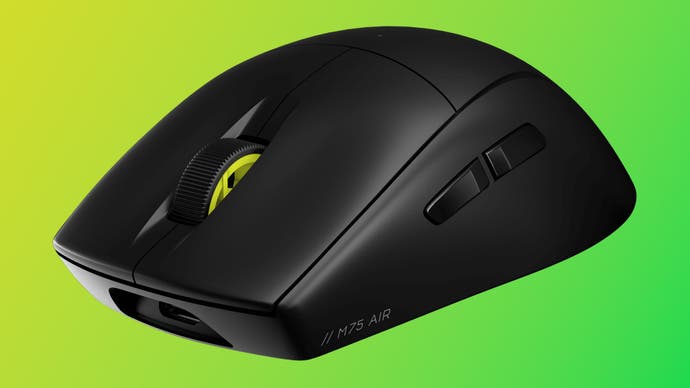
60 grams • PAW3393 sensor • solid symmetric design • 128x65x42mm • up to 1KHz (wireless)
The first in a new breed of Corsair mice, the £98/$80 Corsair M75 Air is a comfortable ultra-light mouse for larger hands that weighs in at just 60g despite its non-ventilated design. The matte coating and shape of the M75's sides are quite easy to grasp, but Corsair does sell grip tape separately - other brands are also available.
Inside, you'll find the same performant PixArt PAW3393 optical sensor and reliable wireless connectivity as the Katar Elite Wireless, with both 2.4GHz Slipstream up to 2000Hz and Bluetooth options allowing you to minimise latency or maximise battery life (up to 35 hours with 2.4GHz or 100 hours with Bluetooth). The mouse can also be used in wired mode, and a flexible cable is provided for this purpose (and charging). While there is room for the wireless dongle to be stowed, making this a good choice for laptop use, switching between modes requires repeated button presses rather than a conceptually simpler switch - likely for weight-saving reasons. Build quality is still excellent though, with no flex or give evident anywhere on the mouse apart from the scroll wheel which can be nudged side to side.
I'm a big fan of the new design philosophy Corsair is pursuing here, including the decision to drop all RGB lighting for the mouse in favour of an all-black design save for the Corsair-yellow scroll wheel internals. This makes sense for a performance-focused peripheral and ironically makes the mouse stand out against most of its peers from Razer, SteelSeries and Logitech. However, dropping the DPI button is a bit off despite allowing for a sleeker design, and I'd have preferred to see this on the underside of the mouse if nowhere else.
If you have medium to large hands, this is definitely the way to go - otherwise, we'd recommend checking out the smaller and more affordable - but slightly heavier - Katar Elite Wireless.
18. Xtrfy MZ1 (Zy's Rail)
Unique form factor worth adapting to

56 grams • PMW3389 sensor • ergonomic honeycomb design • 111x58x37mm • up to 1KHz (wired)
The £51/$49 Xtrfy MZ1 is a unique mouse designed by veteran mouse reviewer Zy, with a unique shape that sets it apart - plus top-tier components from Xtrfy. Despite being relatively short and flat, design elements such as a prominent back hump, deep comfort curves in the buttons and sculpted sides make this mouse surprisingly comfortable to wield. That applies even for those with relatively large hands, although the way you grip the mouse is necessarily different than most others I've tested and therefore there's a bit of a learning curve.
This isn't a fully solid mouse, but I love that all of the areas that you grip don't have any holes in them, and Xtrfy has also coated the internals to provide water and dust protection. The mouse creaks a little when held tightly, and the cable has frayed slightly where it rubbed on the sharp edge of a crummy mouse pad, but neither are genuine issues - I have zero qualms about the build quality here. The mouse can be configured entirely using on-board controls too, no software required. By default, you can adjust the lift-off distance, debounce delay and DPI setting, as well as customise everything about the lighting, from effect and colour to brightness and speed. This works nicely, and the key used for making most changes can be set as the F11 key afterwards so that it can be rebound to be used in games - handy!
Speaking of games: In FPS titles like Call of Duty: Black Ops Cold War and Counter-Strike 2, the MZ1's low weight (56g), Kailh 8.0 switches and latest-gen Xtrfy flexible cable make it a great performer, with the potential for both quick flick shots and stable tracking. I used it for the entirety of my BOCW Season 4 campaign, from levels 0 to 100, and consistently performed as good or better than with some of my all-time favourites like the Razer Viper Ultimate, Logitech G Pro X Superlight and Glorious Model O. Provided you can get over that initial hump of the unusual shape and slightly different grip style, I think this mouse is an underrated performer.
19. Redragon M916 Pro
Anime girl meets genuine ultra-light meets low price
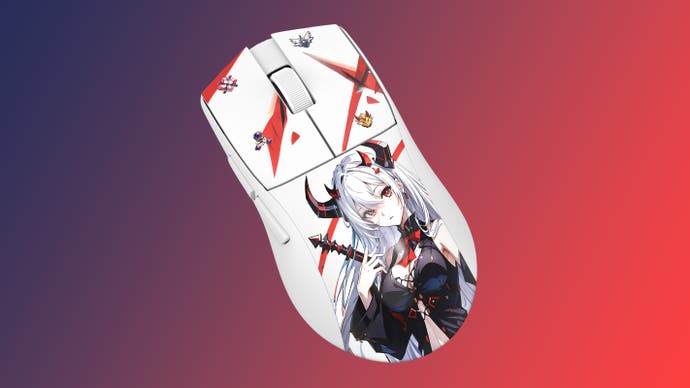
49 grams • PAW3395 sensor • solid ergonomic design • 121x64x38mm • up to 1KHz (wireless)
The (£30/$33) Redragon M916 Pro is a surprisingly excellent ultra-light from the budget mechanical keyboard makers, offering excellent specs and a comfortable shape at a very low price point indeed for a wireless ultra-light. Also, it's got an anime girl on it, though you can opt for a plain version instead for a similar £50/$30 via Amazon.
The shape here is symmetrical and reminds me a bit of the SteelSeries Rival 3, with a minimal hump and gentle comfort grooves in the left and right mouse buttons. There's a high-end PAW3395 sensor and Huano blue dot switches inside, with 1000Hz polling as standard and 4000Hz variants available on the plain-colour variants. The 2.4GHz wireless dongle works reliably enough, and Bluetooth is also available for non-gaming use cases. The skates are a little lacking, but easily replaced if you desire a higher-performance option.
Honestly, if you like the aesthetic, this is a very slick wireless ultra-light for the price.
20. Trust Helox
The cheapest ultra-light mouse

75 grams • PAW3212DB-TJDT optical sensor • honeycomb symmetric design • 125x64x38mm • up to 1KHz (wireless)
The £15 Trust Helox is the cheapest ultra-light we've ever tested, yet it comes with specs that wouldn't have looked too out of place a few years ago on high-end models: 2.4GHz wireless, a 300mAh battery with up to 80 hours of battery life, Huano green dot clicks and a PixArt PAW3212DB-TJDT optical sensor packed into a 75g chassis.
The sensor here isn't great, honestly - its datasheet reveals it's only rated up to 30IPS (inches per second) which you can easily exceed with a quick flick - but it seemed fine enough for gaming in single-player fare like Assassin's Creed: Valhalla and Diablo 4. There are significantly better mice available at around £30, but if £15 is your limit then this is the best I've found.
Ultra-light mice: key specs
Here's how the mice we've recommended over the years rank in terms of weight alone, plus some other key specifications - such as the sensor on board and dimensions. We've classified the designs in two dimensions: "honeycomb" or "solid" based on whether they have external holes and "symmetric" or "ergonomic" based on whether the left and right sides of the mouse are similar shapes. Symmetric mice are the only viable option for left-handers, but many right-handers prefer this style as well. Annoyingly, most "ambidextrous" mice don't include side buttons on both sides, unnecessarily ruling out left-handed use.
| Mouse | Weight | Sensor | Design | Dimensions | Max Polling Rate |
|---|---|---|---|---|---|
| Zaunkoenig M1K | 23g | 3360 | Solid, symmetric | 79x60x30mm | 8KHz |
| Turtle Beach Burst 2 Air | 47g | 3395 | Solid, symmetric | 122x67x39mm | 1KHz |
| G-Wolves Hati S | 48g | 3389 | Honeycomb, symmetric | 113x61x40mm | 1KHz |
| Cooler Master MM720 | 49g | 3389 | Honeycomb, ergonomic | 105x78x37mm | 1KHz |
| Endgame Gear OP1 8K | 51g | 3395 | Solid, symmetric | 118x61x37mm | 8KHz |
| Fnatic x Lamzu Thorn 4K | 51g | 3395 | Solid, ergonomic | 119x65x42mm | 4KHz |
| Cooler Master MM710 | 52g | 3389 | Honeycomb, symmetric | 116x64x38mm | 1KHz |
| Razer Viper V3 Pro | 54g | Focus Pro 35K | Solid, symmetric | 127x64x40mm | 8KHz |
| Razer Deathadder V3 Hyperspeed | 55g | Focus X 26K | Solid, ergonomic | 122x65x41mm | 8KHz* |
| Xtrfy M64 Pro | 55g | 3395 | Solid, ergonomic | 120x65x40mm | 8KHz |
| Xtrfy MZ1 | 56g | 3389 | Honeycomb, ergonomic | 111x58x37mm | 1KHz |
| NZXT Lift 2 Symm | 58g | 3395 | Solid, symmetric | 127x67x38mm | 8KHz |
| Glorious Model O- | 58g | 3360 | Honeycomb, symmetric | 120x63x36mm | 1KHz |
| Glorious Model O 2 Pro 4K/8K | 59g | 3395 | Solid, symmetric | 128x66x38mm | 8KHz |
| Cooler Master MM731 | 59g | 3370 | Solid, ergonomic | 122x69x39mm | 1KHz |
| Xtrfy M42 | 59g | 3389 | Honeycomb, symmetric | 118x63x38mm | 1KHz |
| HyperX Pulsefire Haste | 59g | 3335 | Honeycomb, symmetric | 124x67x38mm | 1KHz |
| Logitech G Pro X Superlight 2 | 60g | Hero 25K | Solid, symmetric | 125x64x40mm | 4KHz |
| Corsair M75 Air | 60g | 3393 | Solid, symmetric | 128x65x42mm | 1KHz |
| Razer Viper Mini | 60g | 3359 | Solid, symmetric | 118x62x38mm | 1KHz |
| SteelSeries Prime Mini | 61g | 3389 | Solid, ergonomic | 120x66x41mm | 1KHz |
| Cooler Master MM711 | 62g | 3389 | Honeycomb, symmetric | 116x64x38mm | 1KHz |
| Endgame Gear XM2we | 63g | 3370 | Solid, symmetric | 122x66x39mm | 1KHz |
| Logitech G Pro X Superlight | 63g | Hero 25K | Solid, symmetric | 125x64x40mm | 1KHz |
| HK Gaming Mira M | 63g | 3360 | Honeycomb, ergonomic | 124x64x40mm | 1KHz |
| Zaopin Z2 | 65g | 3395 | Solid, ergonomic | 123x64x40mm | 4KHz |
| Glorious Model O- Wireless | 65g | 3370 | Honeycomb, symmetric | 120x63x35mm | 1KHz |
| MSI Clutch GM41 Lightweight | 65g | 3389 | Solid, symmetric | 130x67x38mm | 1KHz |
| Incott G Hero Pro | 66g | 3395 | Solid, ergonomic | 119x66x39mm | 8KHz* |
| Roccat Kone Pure Ultra | 66g | 3361 | Solid, ergonomic | 115x70x39mm | 1KHz |
| Xtrfy M4 | 66g | 3389 | Honeycomb, ergonomic | 120x68x39mm | 1KHz |
| Fnatic Bolt | 67g | 3370 | Honeycomb, symmetric | 121x55x39mm | 1KHz |
| Glorious Model O | 67g | 3360 | Honeycomb, symmetric | 128x66x37mm | 1KHz |
| NZXT Lift | 67g | 3389 | Solid, symmetric | 127x67x38m | 1KHz |
| Glorious Model D- Wireless | 67g | 3370 | Honeycomb, ergonomic | 120x66x40mm | 1KHz |
| Mountain Makalu 67 | 67g | 3370 | Honeycomb, ergonomic | 127x70x42mm | 1KHz |
| Roccat Burst Pro | 68g | 3389 | Solid, symmetric | 120x58x38mm | 1KHz |
| Glorious Model D | 68g | 3360 | Honeycomb, ergonomic | 128x68x42mm | 1KHz |
| Corsair Katar Elite Wireless | 69g | 3393 | Solid, symmetric | 116x64x38mm | 1KHz |
| Glorious Model D Wireless | 69g | 3370 | Honeycomb, ergonomic | 128x68x42mm | 1KHz |
| Glorious Model O | 69g | 3370 | Honeycomb, symmetric | 128x66x37mm | 1KHz |
| SteelSeries Prime | 69g | 3389 | Solid, ergonomic | 128x66x37mm | 1KHz |
| Endgame Gear XM1 | 70g | 3389 | Solid, symmetric | 122x66x38mm | 1KHz |
| Xtrfy M4 Wireless | 71g | 3370 | Honeycomb, ergonomic | 120x68x39mm | 1KHz |
| SteelSeries Prime+ | 71g | 3389 | Solid, ergonomic | 128x66x37mm | 1KHz |
| SteelSeries Prime Mini Wireless | 73g | 3335 | Solid, ergonomic | 120x66x41mm | 1KHz |
| Razer Viper Ultimate | 74g | 3399 | Solid, symmetric | 127x66x38mm | 1KHz |
| Glorious Model I 2 | 75g | 3395 | Honeycomb, ergonomic | 129x72x42mm | 1KHz |
| Logitech G303 Shroud Edition | 75g | Hero 25K | Solid, symmetric | 125x64x40mm | 1KHz |
| Logitech G Pro Wireless | 80g | Hero 16K | Solid, symmetric | 125x64x40mm | 1KHz |
| Roccat Burst Pro Air | 81g | 3370 | Solid, symmetric | 120x58x38mm | 1KHz |
*With optional dongle, sold separately
Frequently asked questions
How to measure hand size for a gaming mouse
Your hand size will determine how comfortable a given mouse is to use. Most ultra-light mice will be perfectly usable for the vast majority of hand sizes, but if you have particularly large or small hands then opting for a matching mouse may offer the best results. To find your hand size, keep your fingers together and measure from the tip of your longest finger to your wrist.
- Small hands: Less than 170mm (6.7")
- Medium hands: Between 170 and 195mm (6.7" - 7.7")
- Large hands: More than 195mm (7.7")
You can also measure your hand's width from the bottom of your hand, across your knuckles and past your thumb. You can compare these two hand measurements, length and width, with a mouse that you're considering. A mouse that is about 60 per cent in both dimensions should be suitable for your hand size.
For example, my hand size is 200mm x 100mm, so I personally look for mice that are around 120mm x 60mm. Different grip styles can also influence your ideal mouse size; claw and fingertip grips will hover around the 60 per cent mark, while palm grips are flatter and therefore mice that are closer to 70 per cent of your hand size will feel more comfortable.
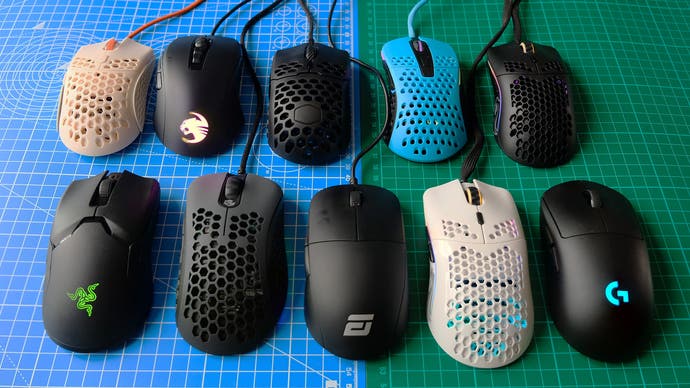
Won't dirt get in the holes?
I don't think it matters. I've been testing ultra-light mice for over five years and I can't see any visible dust or dirt in even my oldest mice. I also haven't noticed any change in performance over time or unexplained failures that could be attributed to honeycomb designs.
Furthermore, there aren't really any components under the holes that would be affected by dirt - just a PCB and potentially RGB lighting, with moving elements like button switches generally covered up. I wouldn't advise eating messy foods or spilling drinks onto an ultra-light mouse, but I wouldn't recommend that with any other kind of computer peripheral either. If you're concerned about this, consider traditional full-body mice like the Roccat Kone Pure Ultra, Endgame Gear XM1 or Logitech G Pro Wireless.
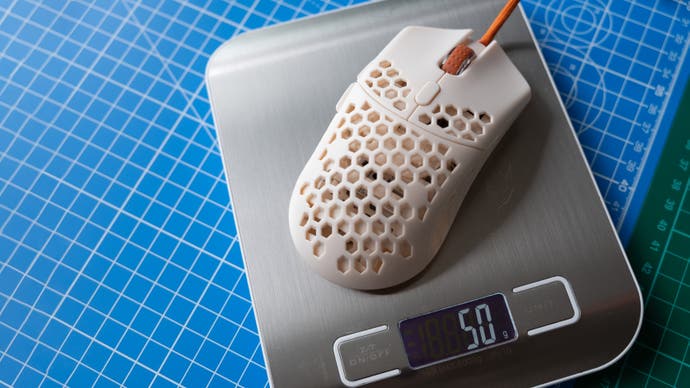
Are ultra-light mice worth it?
Yes, I'd say so. You'll see the greatest benefits to a lighter mouse in fast-paced FPS and battle royale games where aiming quickly and accurately is of paramount importance. Outside of these games, all of the medium to large ultra-light mice I've tested have been perfectly comfortable for general computer use as well.
Most importantly, while there are very expensive ultra-light mice - think of the rare Finalmouse Ultralight 2 and premium Logitech G Pro Wireless - there are also plenty of more affordable options around the £45/$50 mark. Many retailers will accept returns within a certain time window if the mouse is in a saleable condition, so if this is the case for you then it's well worth trying out one of the ultra-lights we've highlighted just to see how you get on.
What do you think of the rankings and which ultra-light is your favourite? Let us know - and iIf there's an ultra-light mouse you think we missed, why not let me know on Twitter @wsjudd?
